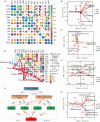Effects of oil pollution on the growth and rhizosphere microbial community of Calamagrostis epigejos
- PMID: 39779932
- PMCID: PMC11711279
- DOI: 10.1038/s41598-025-85754-0
Effects of oil pollution on the growth and rhizosphere microbial community of Calamagrostis epigejos
Abstract
Bacteria, fungi, archaea, and viruses are reflective organisms that indicate soil health. Investigating the impact of crude oil pollution on the community structure and interactions among bacteria, fungi, archaea, and viruses in Calamagrostis epigejos soil can provide theoretical support for remediating crude oil pollution in Calamagrostis epigejos ecosystems. In this study, Calamagrostis epigejos was selected as the research subject and subjected to different levels of crude oil addition (0 kg/hm2, 10 kg/hm2, 40 kg/hm2). Metagenomic sequencing technology was employed to analyze the community structure and diversity of soil bacteria, fungi, archaea, and viruses. Additionally, molecular ecological network analysis was integrated to explore species interactions and ecosystem stability within these microbial communities. The functional profiles of soil microorganisms were elucidated based on data from the KEGG database. Results demonstrated a significant increase in petroleum hydrocarbon content, polyphenol oxidase activity, hydrogen peroxide enzyme activity, and acid phosphatase activity upon crude oil addition, while β-glucosidase content, fiber disaccharide hydrolase content, and tiller number decreased (P < 0.05). Proteobacteria and Actinobacteria were identified as dominant bacterial phyla; Ascomycota, Basidiomycota, and Mucoromycota were found to be dominant fungal phyla; Thaumarchaeota emerged as a dominant archaeal phylum; and Uroviricota represented a dominant viral phylum. The diversity of soil bacterial, fungal, archaeal, and viral communities increased with higher amounts of added crude oil. Ecological network analysis revealed a robust collaborative relationship among bacterial, fungal, archaeal, and viral community species in the control treatment (CK), while strong competitive relationships were observed among these species in the treatments with 10% (F10) and 40% (F40) crude oil concentrations. Structural equation modeling analysis indicated significant positive correlations between fungal community, viral community, enzyme activity, and plant growth; conversely, bacterial and archaeal communities showed significant negative correlations with plant growth (P < 0.05). Correlation analysis identified acid phosphatase as the primary environmental factor influencing soil microbial function. Acid phosphatase levels along with tiller number, aboveground biomass, and petroleum hydrocarbons significantly influenced the fungal community (P < 0.05), while underground biomass had a significant impact on the archaeal community (P < 0.05). Acid phosphatase levels along with cellulose-hydrolyzing enzymes, tiller number, and petroleum hydrocarbons exhibited significant effects on the viral community (P < 0.05). This study investigated variations in bacterial, fungal, archaeal, and viral communities under different crude oil concentrations as well as their driving factors, providing a theoretical foundation for evaluating Calamagrostis epigejos' potential to remediate crude oil pollution.
Keywords: Calamagrostis epigejos; Crude oil addition; Ecological network; Soil microorganisms.
© 2025. The Author(s).
Conflict of interest statement
Declarations. Competing interests: The authors declare no competing interests.
Figures







Similar articles
-
Response of rhizosphere microbial community characteristics and ecosystem multifunctionality to the addition of crude oil in Achnatherum splendens and Pennisetum alopecuroides.Front Microbiol. 2025 Apr 15;16:1553070. doi: 10.3389/fmicb.2025.1553070. eCollection 2025. Front Microbiol. 2025. PMID: 40303472 Free PMC article.
-
Trophic relationships between protists and bacteria and fungi drive the biogeography of rhizosphere soil microbial community and impact plant physiological and ecological functions.Microbiol Res. 2024 Mar;280:127603. doi: 10.1016/j.micres.2024.127603. Epub 2024 Jan 7. Microbiol Res. 2024. PMID: 38199002
-
Remediation of Crude Oil-Polluted Soil by the Bacterial Rhizosphere Community of Suaeda salsa Revealed by 16S rRNA Genes.Int J Environ Res Public Health. 2020 Feb 25;17(5):1471. doi: 10.3390/ijerph17051471. Int J Environ Res Public Health. 2020. PMID: 32106510 Free PMC article.
-
Archaea Biotechnology.Biotechnol Adv. 2021 Mar-Apr;47:107668. doi: 10.1016/j.biotechadv.2020.107668. Epub 2020 Dec 1. Biotechnol Adv. 2021. PMID: 33271237 Review.
-
FAQ: Microbes & Oil Spills.Washington (DC): American Society for Microbiology; 2011. Washington (DC): American Society for Microbiology; 2011. PMID: 33054146 Free Books & Documents. Review.
Cited by
-
Comparative metagenomics on community structure and diversity of rhizomicrobiome associated with monoculture and soybean precedent carrot.Sci Rep. 2025 Aug 1;15(1):28161. doi: 10.1038/s41598-025-13605-z. Sci Rep. 2025. PMID: 40750823 Free PMC article.
References
-
- Liang, W. & Yang, M. Urbanization, economic growth and environmental pollution: Evidence from China. Sustain. Comput. Inf. Syst.21, 1–9 (2019).
-
- Zhang, B., Matchinski, E. J., Chen, B., Ye, X., Jing, L. & Lee, K. Marine oil spills—oil pollution, sources and effects. In World seas: an environmental evaluation. 391–406 (Elsevier, 2019).
-
- Schlatter, D. C., Kahl, K., Carlson, B., Huggins, D. R. & Paulitz, T. Soil acidification modifies soil depth-microbiome relationships in a no-till wheat cropping system. Soil Biol. Biochem.149, 107939 (2020).
-
- Koshila Ravi R, Anusuya S, Balachandar M, Muthukumar T. Microbial interactions in soil formation and nutrient cycling. Mycorrhizosphere and pedogenesis. 363–382 (2019).
Publication types
MeSH terms
Substances
Grants and funding
- 22NYYF029/Xi'an Agricultural Technology R&D Projects
- S2024-JC-YB-2574/Natural Science Foundation of Science and Technology Department of Shaanxi Province
- 2020ZDLSF06-01/Natural Science Foundation of Science and Technology Department of Shaanxi Province
- 2021K-25/Strategic Reserve Talent Training Program of Shaanxi Academy of Sciences
- 2023JH-NJGG-0167/Xi'an Science Technology Bureau Fund
LinkOut - more resources
Full Text Sources
Medical
Research Materials
Miscellaneous

